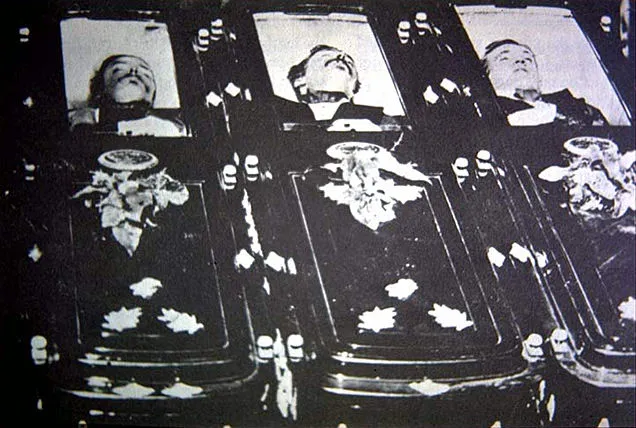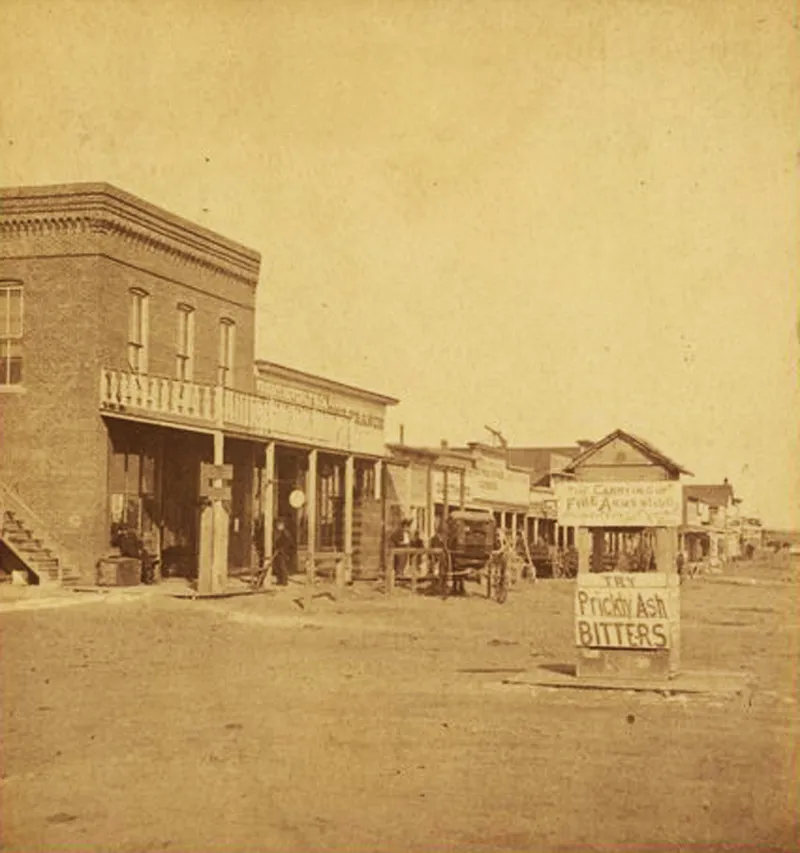If Guns Were Mandatory Would We Become the West Again
/https://tf-cmsv2-smithsonianmag-media.s3.amazonaws.com/filer/da/bc/dabc3b99-f221-4392-8e0a-a3b3f3d98af5/wright1913_dodge_city_in_1878_14782835852.jpg)
It's Oct 26, 1881, in Tombstone, and Arizona is not however a land. The O.Grand. Corral is tranquillity, and it's had an unremarkable being for the two years it'south been standing—although it's nigh to go famous.
Marshall Virgil Earp, having deputized his brothers Wyatt and Morgan and his pal Md Holliday, is having a gun control problem. Long-running tensions between the lawmen and a faction of cowboys – represented this morning by Billy Claiborne, the Clanton brothers, and the McLaury brothers – will come to a head over Tombstone's gun law.
The laws of Tombstone at the time required visitors, upon entering boondocks to disarm, either at a hotel or a lawman's role. (Residents of many famed cattle towns, such equally Dodge City, Abilene, and Deadwood, had similar restrictions.) But these cowboys had no intention of doing so as they strolled around town with Filly revolvers and Winchester rifles in obviously sight. Earlier on this fateful day, Virgil had disarmed one cowboy forcefully, while Wyatt confronted another and county sheriff Johnny Behan failed to persuade two more to turn in their firearms.
When the Earps and Holliday met the cowboys on Fremont Street in the early afternoon, Virgil over again called on them to disarm. Nobody knows who fired showtime. Ike Clanton and Billy Claiborne, who were unarmed, ran at the start of the fight and survived. Billy Clanton and the McLaury brothers, who stood and fought, were killed by the lawmen, all of whom walked abroad.
The "Old West" conjures up all sorts of imagery, only broadly, the term is used to evoke life amidst the crusty prospectors, threadbare gold panners, madams of brothels, and vi-shooter-packing cowboys in small frontier towns – such as Tombstone, Deadwood, Dodge City, or Abilene, to name a few. One other matter these cities had in mutual: strict gun control laws.

"Tombstone had much more restrictive laws on carrying guns in public in the 1880s than information technology has today," says Adam Winkler, a professor and specialist in American constitutional constabulary at UCLA School of Law. "Today, you're allowed to carry a gun without a license or permit on Tombstone streets. Back in the 1880s, you lot weren't." Same goes for almost of the New Westward, to varying degrees, in the once-rowdy frontier towns of Nevada, Kansas, Montana, and S Dakota.
Dodge City, Kansas, formed a municipal authorities in 1878. According to Stephen Aron, a professor of history at UCLA, the first constabulary passed was i prohibiting the behave of guns in town, likely by civic leaders and influential merchants who wanted people to move there, invest their time and resources, and bring their families. Cultivating a reputation of peace and stability was necessary, fifty-fifty in bouncy towns, if it were to become anything more transient than a one-industry smash town.
Laws regulating buying and carry of firearms, autonomously from the U.South. Constitution'south Second Amendment, were passed at a local level rather than by Congress. "Gun control laws were adopted pretty quickly in these places," says Winkler. "Well-nigh were adopted by municipal governments exercising cocky-command and cocky-decision." Carrying any kind of weapon, guns or knives, was non allowed other than outside town borders and inside the home. When visitors left their weapons with a law officer upon entering town, they'd receive a token, like a coat check, which they'd exchange for their guns when leaving town.
The practice was started in Southern states, which were among the first to enact laws against concealed bear of guns and knives, in the early 1800s. While a few citizens challenged the bans in court, almost lost. Winkler, in his volumeGunfight: The Battle Over the Right to Bear Arms in America,points to an 1840 Alabama court that, in upholding its land ban, ruled it was a country'due south right to regulate where and how a citizen could carry, and that the state constitution's allowance of personal firearms "is non to deport arms upon all occasions and in all places."
Louisiana, too, upheld an early ban on concealed bear firearms. When a Kentucky court reversed its ban, the state constitution was amended to specify the Kentucky general assembly was within its rights to, in the future, regulate or prohibit concealed carry.
Still, Winkler says, it was an affidavit that regulation was compatible with the Second Amendment. The federal government of the 1800s largely stayed out of gun-law court battles.
"People were allowed to ain guns, and everyone did ain guns [in the West], for the most role," says Winkler. "Having a firearm to protect yourself in the lawless wilderness from wild animals, hostile native tribes, and outlaws was a wise idea. Only when you came into boondocks, you had to either bank check your guns if you were a visitor or go along your guns at home if y'all were a resident."
Published in 1903, Andy Adams'due southLog of a Cowboy,a "slightly fictionalized" account of the author's life on the cattle trails of the 1880s, was a refutation against the myth-making dime store novels of the mean solar day. The book, which included stories about lawless cowboys visiting Dodge City firing into the air to shoot out lights, has been called the almost realistic written business relationship of cowboy life and is nevertheless in print today.
Adams wrote of what happened to the few who wouldn't comply with frontier gun law:
"The buffalo hunters and range men accept protested against the iron rule of Dodge's peace officers, and nearly every protest has toll man life. … Nearly cowboys think it's an infringement on their rights to give up shooting in boondocks, and if information technology is, it stands, for your half dozen-shooters are no match for Winchesters and buckshot; and Dodge's officers are every bit game a set of men every bit ever faced danger."
Frontier towns with and without gun legislation were tearing places, more violent than family unit-friendly farming communities and Eastern cities of the time, but those without restrictions tended to have worse violence. "I've never seen any rhetoric from that fourth dimension period maxim that the simply thing that's going to reduce violence is more people with guns," says Winkler. "It seems to exist much more of a 20th-century attitude than ane associated with the Wild West."

Aron agrees that these debates rarely went on, and if they did, there'south scant prove of it today.
Crime records in the One-time W are sketchy, and even where they be the modern FBI yardstick of measuring homicides rates – the number of homicides per 100,000 residents – can exaggerate statistics in Old Western towns with small populations; even one or two more murders a yr would drastically swing a town's homicide rate.
Historian Robert Dykstra focused on established cattle towns, recording homicides after a total season of cattle shipments had already passed and past which time they'd have typically passed firearm police. He found a combined 45 murders from 1870-1885 in Kansas' five largest cattle towns past the 1880 census: Wichita (population: four,911), Abilene (2,360) Caldwell (i,005), Ellsworth (929), and Dodge City (996).
Averaged out, in that location were 0.6 murders per town, per yr. The worst years were Ellsworth, 1873, and Dodge City, 1876, with five killings each; because of their small populations, their FBI homicide rates would be loftier. Another historian, Rick Shenkman, establish Tombstone's (1880 pop: 3,423) about violent year was 1881, in which also only five people were killed; three were the cowboys shot by Earp's men at the OK Corral.
As Dykstra wrote, frontier towns by and large prohibited the "conveying of dangerous weapons of whatsoever type, curtained or otherwise, by persons other than law enforcement officers." Most established towns that restricted weapons had few, if whatsoever, killings in a given yr.
The settlements that came closest to unchecked comport were the railroad and mining blast towns that tended to lack effective law enforcement, a functioning judicial system, and firearm law, says Aron, and it reflected in higher levels of violence. Like Bodie, California, which was well-known during the 1870s and 1880s for vigilantism and street violence.
"The smoke of battle well-nigh never clears away completely in Bodie," wrote a young Mark Twain on assignment for theVirginia Metropolis Territorial Enterprise.Historian Roger McGrath constitute that from 1877 to 1882 there were 31 homicides in Bodie which, according to the 1880 census, had only 2,712 residents. Equally the contemporary paperSacramento Matrimonycalled it a "shooter'south boondocks," Bodie by 1880 had acquired a national infamy. Fifty-fifty every bit far as New York, a dangerous man was euphemistically called "a bad man from Bodie."
The one-man police seen of Boob tube and pic Westerns is how we remember the West today. Information technology was a time and place where rugged individualism reigned and the merely law in the West that mattered was the police on your hip – a gun. Nigh "cowboy" films had zero to practice with driving cattle. John Wayne grew his brand every bit a horseback vigilante in decades' worth of Westerns, from his first leading function in 1930'southThe Big Trailto 1971'sLarge Jake, in which the law fails and Wayne's everyman is the only justice.
But every bit the classicThe Man Who Shot Liberty Valance tells us, "This is the West, sir. When the legend becomes fact, print the fable."
Every bit the W adult, towns pushed this mythos of the West as their founding ideology. Lax gun laws were merely a role of an individualistic streak that manifested itself with the explosion in popularity of concealed comport licenses and the broader acceptance of openly carrying firearms (open-carry laws) that crave no permit.
"These Wild West towns, as they adult and became more civilized and larger, there was an endeavour to promote their Wild West heritage very aggressively, and that became the identity of the town," says Winkler, "merely that identity was based on a faux understanding of what the by was similar, and wasn't a real cess of what places like Tombstone were similar in the 1880s."
So the orthodox positions in America'due south ongoing gun debate oscillate between "Whatsoever gun law is a retreat away from the lack of regime interference that fabricated this state great" and "If we don't regulate firearms, we'll end up like the Wild West," robbing both sides of a historical bedrock of how and why gun constabulary developed every bit America expanded Westward.
Source: https://www.smithsonianmag.com/history/gun-control-old-west-180968013/
0 Response to "If Guns Were Mandatory Would We Become the West Again"
Post a Comment